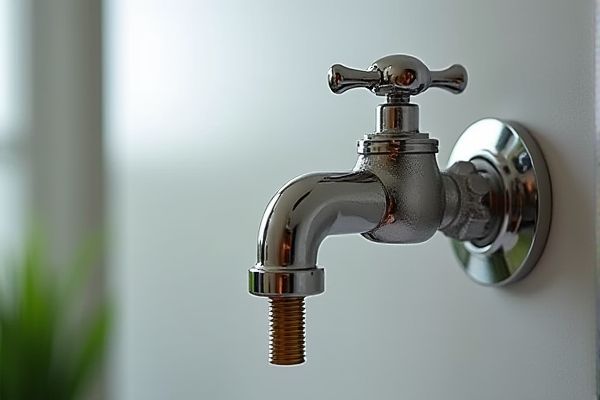
Thermostatic valves maintain a consistent water temperature by automatically adjusting the hot and cold water mix, ensuring a comfortable and safe shower experience, while pressure balance valves regulate water pressure to prevent sudden temperature changes caused by fluctuations in water supply. Understanding the differences between these valves can help you choose the best option for your bathroom setup; explore the rest of the article to make an informed decision.
Table of Comparison
| Feature | Thermostatic Valve | Pressure Balance Valve |
|---|---|---|
| Function | Maintains consistent water temperature by adjusting flow | Maintains water pressure balance to prevent temperature fluctuations |
| Temperature Control | Precise temperature regulation with preset or adjustable thermostat | Indirect temperature control by balancing pressure only |
| Response to Pressure Changes | Automatically adjusts mix to maintain temperature despite pressure changes | Adjusts valve to balance hot and cold water pressure |
| Installation | Typically more complex and expensive | Simple, cost-effective installation |
| Safety | Prevents scalding by precise temp control, ideal for sensitive users | Reduces risk of sudden temperature spikes but less precise |
| Applications | High-end showers, health care, and commercial use | Residential showers and baths |
| Maintenance | Requires occasional calibration or service | Low maintenance |
Introduction to Shower Valve Technologies
Thermostatic valves maintain a consistent water temperature by automatically adjusting hot and cold water mix, enhancing safety and comfort during showers. Pressure balance valves regulate water pressure changes within the plumbing system to prevent sudden temperature fluctuations caused by demand elsewhere in the home. Both technologies improve shower experience, with thermostatic valves offering precise temperature control and pressure balance valves providing stable pressure management.
What Is a Thermostatic Valve?
A thermostatic valve maintains a consistent water temperature by automatically adjusting the mix of hot and cold water to the desired setpoint. It responds to temperature changes, ensuring safety and comfort by preventing sudden temperature fluctuations or scalding. This valve is ideal for precise temperature control in showers and baths, enhancing user experience and energy efficiency.
What Is a Pressure Balance Valve?
A pressure balance valve maintains consistent water temperature by automatically adjusting the mix of hot and cold water when pressure changes occur in the plumbing system. Unlike a thermostatic valve, which allows precise temperature settings, a pressure balance valve protects Your shower from sudden temperature fluctuations caused by water usage elsewhere in the home. This valve is essential for preventing scalding or cold shocks, ensuring a safer and more comfortable shower experience.
Key Differences Between Thermostatic and Pressure Balance Valves
Thermostatic valves maintain a consistent water temperature by automatically adjusting the mix of hot and cold water, ensuring precise temperature control even with fluctuating water pressure. Pressure balance valves regulate water pressure to prevent sudden temperature changes caused by water pressure shifts but do not control the temperature as accurately as thermostatic valves. You can achieve safer and more comfortable shower experiences by choosing thermostatic valves for precise temperature management or pressure balance valves for basic pressure fluctuation protection.
Temperature Control Precision
Thermostatic valves provide superior temperature control precision by continuously monitoring and adjusting water temperature to maintain a consistent setting, preventing sudden fluctuations. Pressure balance valves regulate temperature by balancing incoming hot and cold water pressure but respond slower to changes, causing potential temperature swings. This makes thermostatic valves ideal for environments requiring exact temperature maintenance and enhanced safety against scalding.
Safety Features Comparison
Thermostatic valves maintain a consistent water temperature by automatically adjusting the mix of hot and cold water, reducing the risk of scalding or sudden temperature fluctuations. Pressure balance valves respond to changes in water pressure to prevent sudden temperature spikes when there is a drop in cold or hot water flow, providing basic protection against thermal shock. Thermostatic valves offer superior safety by precisely controlling temperature, while pressure balance valves primarily ensure stable pressure to minimize abrupt temperature changes.
Installation and Maintenance Requirements
Thermostatic valves require precise calibration during installation to ensure accurate temperature control, often necessitating professional expertise for optimal performance. Pressure balance valves are generally easier to install due to simpler mechanisms that maintain consistent water pressure, reducing the risk of scalding without complex adjustments. Maintenance of thermostatic valves involves periodic cleaning and sensor checks to prevent temperature fluctuations, whereas pressure balance valves demand less frequent servicing but may need cartridge replacement to maintain pressure stability.
Water Efficiency and Performance
Thermostatic valves regulate water temperature precisely, enhancing water efficiency by reducing unnecessary fluctuations and conserving water during adjustments. Pressure balance valves maintain consistent water pressure, preventing sudden temperature changes but may allow minor temperature variations, potentially affecting performance and water use. Choosing a thermostatic valve can optimize Your water savings and comfort through precise temperature control and stable flow.
Cost Comparison and Value
Thermostatic valves typically cost more upfront, ranging from $150 to $300, due to their advanced temperature regulation and safety features, while pressure balance valves usually range between $50 and $150. The higher investment in thermostatic valves offers greater value through precise temperature control, energy savings, and reduced risk of scalding, making them ideal for households with children or elderly residents. Pressure balance valves provide cost-effective basic protection against sudden temperature changes but lack the enhanced comfort and efficiency benefits of thermostatic models.
Which Valve Is Right for Your Bathroom?
Thermostatic valves maintain a consistent water temperature by automatically adjusting hot and cold flow, ideal for households with varying water pressures or where precise temperature control is essential. Pressure balance valves regulate pressure changes between hot and cold water to prevent sudden temperature spikes, offering a reliable and cost-effective solution for basic shower setups. Choosing the right valve depends on your bathroom's plumbing system, desired temperature stability, and budget considerations.
 homyna.com
homyna.com